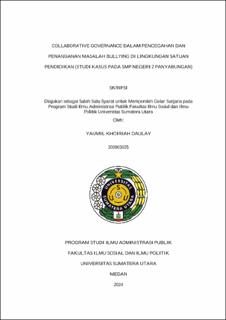| dc.description.abstract | This research aims to find out and describe collaborative governance in
preventing and handling bullying in the education unit environment in Mandailing
Natal Regency, focusing on SMP Negeri 2 Panyabungan. Bullying is a form of
violence that often occurs in the educational environment and has a negative
impact on the physical and psychological development of victims. Collaborative
governance, which involves the government, educational institutions, parents and
the community, is considered an effective strategy in dealing with this problem.
This research used descriptive qualitative research methods. Research
informants included the Head of the Mandailing Natal Regency Education and
Culture Office, the Head of the Child Rights Protection and Fulfillment Division,
school principals, NGOs and parents. Data were collected through primary data
and secondary data with data collection techniques in the form of in-depth
interviews, observation, and documentation. This research uses Ansell and Gash's
collaborative governance model (2008), which includes initial conditions,
institutional design, leadership, and collaborative processes.
The research results from the application of the collaborative
governance model according to Ansell and Gash in preventing and handling
bullying problems in the education unit environment show that the initial
conditions in this collaboration process have the same goals and motivations of
the parties involved, namely to create a safe and comfortable school environment
and protect children's rights. The institutional design in this collaboration is also
based on the Mandailing Natal Regent Decree. And the leadership of the
agencies, schools, and NGOs is good enough in carrying out their roles for the
prevention and handling of bullying problems. However, in the collaboration
process there are several obstacles such as the lack of involvement from parents,
the programs carried out in the prevention and handling of bullying problems are
still lacking, and the lack of socialization of anti-bullying policies in schools. It is
necessary to increase the role and collaboration between schools, government,
NGOs and the community in bullying prevention in order to create a safe and
conducive educational environment. In addition, the agency and schools should
make banners or brochures about bullying as one of the first steps in preventing
bullying problems. | en_US |


